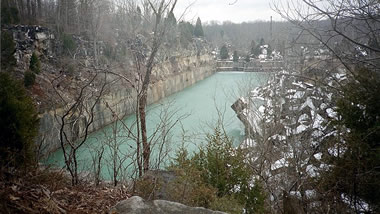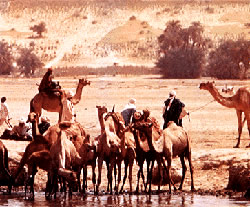Land is easily damaged and degraded by the activities of mankind.
In some industrial areas, severe air pollution has damaged soils and vegetation to the extent that agriculture is no longer possible there.
The dumping of industrial waste has also contaminated land and made it unproductive, and sizeable areas have been rendered useless by the effects of mining.
The side-effects of industry on the land may be severe, but they are usually confined to relatively small areas. Conversely, agriculture, grazing and forestry may have extensive destructive effects on land although they seem less dramatic and are less rapid than those of industry.
Effects of Industry
The pollution of the air from industrial plants (such as metal smelters) can cause considerable damage to plant life and soil. Some gases, such as sulfur dioxide, released by factories dissolve in rain to form a weak acid, which is extremely harmful to the environment and to human health.
 Quarrying and mining, particularly open-cast mining, leave soil unprotected and accelerate erosion. Attempts are made in some places to refill open mined areas with topsoil and to plant vegetation on it to reduce the damage. But this is not always done and erosion follows.
Quarrying and mining, particularly open-cast mining, leave soil unprotected and accelerate erosion. Attempts are made in some places to refill open mined areas with topsoil and to plant vegetation on it to reduce the damage. But this is not always done and erosion follows.
In addition, rain leaches salts out of the exposed soil, which increase its acidity and the acid run-off sterilizes the soil downslope.
Mining also leads to subsidence of the land - which damages buildings and roads - and heaps of waste material mar the landscape. The Potteries near Stoke on Trent in England illustrated early industrial dereliction with disused pits, slagheaps and coaltips.
Deforestation
To create new land for agriculture and settlement and to satisfy the need for timber the world's tropical rainforest is being felled and burned at a rate of about 110,000sq km a year, at this rate it will have disappeared completely in 50 years.
Forest removal has been practiced for centuries, but the onslaught on the tropical forest is especially drastic because its complex of soils and vegetation is so fragile. The chief source of plant nutrients is in the vegetation rather than in the soil; if the vegetation is removed, much of the land's fertility is lost.
Once a forest is cleared, a greater degree of rainfall runs off the soil surface directly, and soil erosion is increased. The erosion of topsoil makes the land less productive and also causes land and waterways down-stream to silt up. In the Himalayas, for example, farmers and peasants in the past gathering fuel denuded hills, thus increasing erosion and flooding in the lower plains.
In the 1930s, the United States suffered badly from soil erosion. The North American plains had been deforested and the exposed topsoil was blown away, leaving a barren, extensive dustbowl.
Soil usually develops very slowly, even when undisturbed under natural vegetation. It may take from 100 to 400 or more years to generate 1cm of topsoil. On cultivated land the soil is usually unprotected by crops or vegetation for part of the year, and the rate of soil loss is almost always higher than the rate of soil formation. It is estimated, for example, that the amount of soil lost in one year from maize-growing land in Iowa, in the United States, is equivalent to the amount that forms naturally in eleven years.
Soil erosion may result in a loss of both nutrients and soil-rooting depth. Whereas it may be possible, at a price, to replace nutrients by the application of fertilizers, the loss of rooting depth is irreplaceable.
Overgrazing
Soil erosion is not confined to cropland, but also takes place on grazing land. If pastures are overstocked, or if grazing is uncontrolled, then the vegetation is adversely affected. Such reduction of plant cover occurs especially in the semi-arid areas where many of the world's pasture lands are located. If the vegetation cover is reduced, then the soil surface is less protected and erosion is accelerated.
 As population pressure increases, there is a tendency for agriculturists to move into more marginal areas and pastoralists are in turn displaced into more arid areas. In the Sahel of Africa, for example, which extends from Senegal in the west to Ethiopia in the east, overstocking severely degraded huge areas of land and contributed to the spread of the Sahara. In addition, the slash-and-burn agriculture practiced on the margins reduced the vegetation cover and a severe drought in that area further aggravated the problem.
As population pressure increases, there is a tendency for agriculturists to move into more marginal areas and pastoralists are in turn displaced into more arid areas. In the Sahel of Africa, for example, which extends from Senegal in the west to Ethiopia in the east, overstocking severely degraded huge areas of land and contributed to the spread of the Sahara. In addition, the slash-and-burn agriculture practiced on the margins reduced the vegetation cover and a severe drought in that area further aggravated the problem.
Land Reclamation Failures
In a few parts of the world, the desert has been made to bloom by the use of irrigation. Such programs transform the productivity of the land, but sometimes they suffer from technical problems: waterlogging of the soil, or growth of crusts of salt or other chemicals that render the land unproductive.
In Pakistan, for example, an irrigation project backfired when the amount of salt in the soil rose so high that it became unusable for agriculture.
In addition, dams constructed to bring water to dry areas have caused massive damage to the landscape with the loss of plant and animal life as well as of agricultural land.
With modern population pressures, many agricultural problems are more acute than ever before. Unless more appropriate forms of land management can be practiced in many parts of the world, the prospects for adequate resources in future are gloomy.